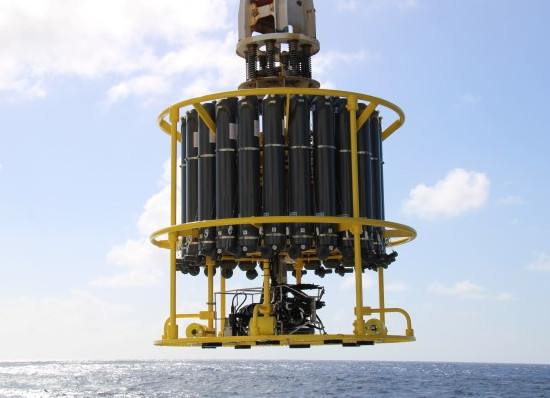|
Hawaii Ocean Time-series (HOT)
in the School of Ocean and Earth Science and Technology at the University of Hawai'i at Manoa |
|
| » Home » Analytical Results » Biogeochemistry | ||||||||
Sampling at Station ALOHA typically begins with sediment trap deployment followed by a deep (> 4700 m) CTD cast and a "burst series" of at least 13 consecutive 1000 m casts, on 3-h intervals, to span the local inertial period (~ 31 h) and three semidiurnal tidal cycles. The repeated CTD casts enable us to calculate an average density profile from which variability on tidal and near-inertial time scales has been removed. These average density profiles are useful for the comparison of dynamic height and for the comparison of the depth distribution of chemical parameters from different casts and at monthly intervals. This sampling strategy is designed to assess variability on time scales of a few hours to a few years. Very high frequency variability (< 6 h) and variability on time scales of between 3-60 d are not adequately sampled with our ship-based operations. Water samples for a variety of chemical and biological measurements are routinely collected from the surface to within 10 m of the seafloor. To the extent possible, we collect samples for complementary biogeochemical measurements from the same or from contiguous casts to minimize aliasing caused by time-dependent changes in the density field. This approach is especially important for samples collected in the upper 350 m of the water column. Furthermore, we attempt to sample from common depths and specific density horizons each month to facilitate comparisons between cruises. Water samples for salinity determinations are collected from every water bottle to identify sampling errors. Approximately 20% of the water samples are collected and analyzed in duplicate or triplicate to assess and track our precision in sample analyses. At Stations Kahe, ALOHA and Kaena, water samples for chemical analyses were collected from discrete depths using 12 liter PVC bottles with nylon coated internal springs as closing mechanisms. Sampling strategies and procedures are well documented in the previous Data Reports and in the HOT Program Field and Laboratory Protocols manual. | ||||||||


